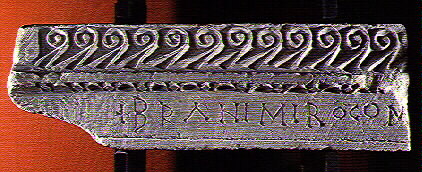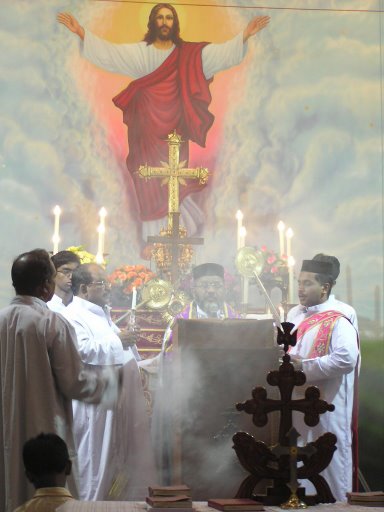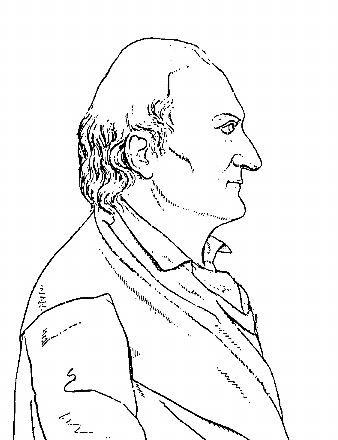|
Church Of Holy Salvation, Cetina
The Church of the Holy Salvation or Holy Saviour ( hr, Crkva Sv. Spasa) was a Pre-Romanesque church in the Dalmatian Hinterland, Croatia, whose ruins are now a historic site. It is located in the small village of Cetina, near the spring of the river Cetina, 8 km northwest from the town of Vrlika. The remains of the church are of historical significance in Croatia, as it is the only pre-schism church constructed with a bell tower which is still standing. Description The church was once a one-longitudinal-nave structure with a sanctuary consisting of three apses, in the form of a trefoil on the eastern end. During later reconstruction, the middle apse was pulled down and substituted by a larger, rectangular one. An imposing bell-tower was positioned in front of entrance along with the two-story westwork in front of the church's nave. Westwork is a notable feature of Carolingian architecture, which was at its peak in Europe during the 9th century. The church is vaulted with ... [...More Info...] [...Related Items...] OR: [Wikipedia] [Google] [Baidu] |
Christianity
Christianity is an Abrahamic monotheistic religion based on the life and teachings of Jesus of Nazareth. It is the world's largest and most widespread religion with roughly 2.38 billion followers representing one-third of the global population. Its adherents, known as Christians, are estimated to make up a majority of the population in 157 countries and territories, and believe that Jesus is the Son of God, whose coming as the messiah was prophesied in the Hebrew Bible (called the Old Testament in Christianity) and chronicled in the New Testament. Christianity began as a Second Temple Judaic sect in the 1st century Hellenistic Judaism in the Roman province of Judea. Jesus' apostles and their followers spread around the Levant, Europe, Anatolia, Mesopotamia, the South Caucasus, Ancient Carthage, Egypt, and Ethiopia, despite significant initial persecution. It soon attracted gentile God-fearers, which led to a departure from Jewish customs, and, a ... [...More Info...] [...Related Items...] OR: [Wikipedia] [Google] [Baidu] |
Duke Branimir
Branimir ( la, Branimiro) was a ruler of Croatia who reigned as duke ( hr, knez) from 879 to 892. His country received papal recognition as a state from Pope John VIII on 7 June 879. During his reign, Croatia retained its sovereignty from both Frankish and Byzantine rule and became ''de jure'' independent.''Hrvatski leksikon'' (1996–1997) Stjepan Antoljak, Pregled hrvatske povijesti, Split 1993., str. 43. Reign Rise to power In 879, Branimir had Duke Zdeslav, a supporter of the Byzantine Empire, killed near Knin in a rebellion that he led. Approval from the Holy See was brought about by Branimir's own actions to bring the Croats further away from the influence of Byzantium and closer to Rome. Duke Branimir wrote to Pope John VIII affirming this split from Byzantine and commitment to the Roman Papacy. During the solemn divine service in St. Peter's church in Rome in 879, Pope John VIII gave his blessing to the duke and the whole Croatian people, about which he informed Bra ... [...More Info...] [...Related Items...] OR: [Wikipedia] [Google] [Baidu] |
Lujo Marun
Aloysius "Lujo" Marun (born Stipe Marun 11 December 1857 – 15 January 1939) was a Croatian Franciscan priest, who is known as the pioneer of Croatian archeology. Biography He was born as Stipe Marun in the town of Skradin, northern Dalmatia. After finishing primary school in Sinj, he went to Visovac Monastery where he studied to become a Franciscan, taking the monastic name Aloysius (shortened to Lujo). Even before entering the priesthood, Marun's teachers had instilled in him an awakened national consciousness which turned him to research Croatian monuments. He knew that the medieval Croatian kingdom was concentrated in northern Dalmatia, which would be where most of his life's work would take him. Although he was not trained in archeology, he nevertheless participated in excavations in Knin in the early 1880s, and eventually managed to get transferred there in 1885. He died in Knin in 1939. Legacy In 2016, the "Fr. Lujo Marun" Student Residence Hall was opened near t ... [...More Info...] [...Related Items...] OR: [Wikipedia] [Google] [Baidu] |
Ascension Day
The Solemnity of the Ascension of Jesus Christ, also called Ascension Day, Ascension Thursday, or sometimes Holy Thursday, commemorates the Christian belief of the bodily Ascension of Jesus into heaven. It is one of the ecumenical (i.e., shared by multiple denominations) feasts of Christian churches, ranking with the feasts of the Passion and Pentecost. Following the account of that the risen Jesus appeared for 40 days prior to his Ascension, Ascension Day is traditionally celebrated on a Thursday, the fortieth day of Easter; although some Christian denominations have moved the observance to the following Sunday. The day of observance varies by ecclesiastical province in many Christian denominations, as with Methodists and Catholics, for example. History The observance of this feast is of great antiquity. Eusebius seems to hint at the celebration of it in the 4th century. At the beginning of the 5th century, Augustine of Hippo says that it is of Apostolic origin, and he speaks o ... [...More Info...] [...Related Items...] OR: [Wikipedia] [Google] [Baidu] |
Stjepan Zlatović
Stjepan is a Croatian masculine given name, variant of Stephen, used by ijekavian speakers. In Croatia, the name Stjepan was among the top ten most common masculine given names in the decades up to 1969. Notable people with the name include: * Stjepan Držislav of Croatia, Croatian monarch * Stjepan II of Croatia, Croatian monarch * Stjepan Svetoslavić, Croatian nobleman * Stjepan Andrijašević, Croatian footballer * Stjepan Babić, Croatian linguist * Stjepan Babić (footballer), Croatian footballer * Stjepan Bobek, Croatian footballer * Stjepan Božić, Croatian boxer * Stjepan Brodarić, Croatian cleric * Stjepan Deverić, Croatian footballer * Stjepan Damjanović, Croatian linguist * Stjepan Đureković, Croatian businessman * Stjepan Filipović, Croatian partisan * Stjepan Gomboš, Croatian architect * Stjepan Gradić, Croatian polymath * Stjepan Hauser, Croatian cellist * Stjepan Horvat, Croatian geodesist * Stjepan Ivšić, Croatian linguist * Stjepan Janić, Croatia ... [...More Info...] [...Related Items...] OR: [Wikipedia] [Google] [Baidu] |
Ivan Lovrić
Ivan Lovrić (also ''Giovanni Lovrich''; c. 1756 in Sinj – 1777 in Sinj) was a Croatian writer, ethnographer, and medical student from the Republic of Venice, best known for his work ''Observations on 'Travels in Dalmatia' of Abbot Alberto Fortis''. Biography Born in Sinj to a relatively wealthy Croatian merchant family, Lovric studied linguistics in Venice and then medicine in Padua. His early death in 1777 was preceded by numerous works, most notably ''Osservazioni di Giovanni Lovrich sopra diversi pezzi del viaggio in Dalmazia del signor abbot Alberto Fortis coll'aggiunta della vita di Soçivizça'' ("Observations of Giovanni Lovrich van Lovrićon several pieces of the journey to Dalmatia of Mr. Abbot Alberto Fortis with the addition of the life of Soçivizça") (1776), including a history of the life of Stanislav Sočivica Stanislav "Stanko" Sočivica ( 1715 – 1777) was a Serbian ''hajduk'' (brigand) active in the Ottoman territories in western Balkans (sanjaks ... [...More Info...] [...Related Items...] OR: [Wikipedia] [Google] [Baidu] |
Alberto Fortis
Alberto Fortis (1741–1803) was a Republic of Venice, Venetian writer, naturalist and cartographer. Life His real name was Giovanni Battista Fortis (his religious name was ''Alberto'') and he was born in Padua on either 9 or 11 of November 1741. He journeyed extensively in Venetian Dalmatia. His best known work is ''Viaggio in Dalmazia'' ("Journey to Dalmatia"), originally published in 1774 and first published in London in 1778. The highlight of the book is the description of Morlachia, a historical region currently located in Croatia named after the Morlachs that inhabited the region. In his book, Fortis presented his literary discovery "Hasanaginica" as a Morlach (Vlach) ballad. Larry Wolf believed Fortis wrote the ballad as a poetry of South Slavs rather than a poetry of the Morlachs. Fortis believed that the Morlachs preserved their old customs and clothes. Their ethnographic traits were traditional clothings, use of the gusle musical instrument accompanied with epic singing ... [...More Info...] [...Related Items...] OR: [Wikipedia] [Google] [Baidu] |
Turopolje
Turopolje () is a region in Croatia situated between the capital city Zagreb and Sisak. The administrative center of the region Turopolje is the town of Velika Gorica. Geography Turopolje forms a part of Posavina, a region to the south of Zagreb bordering the right banks of the Sava river on the east, and the Vukomericke Gorice hills to the southwest. It extends across an alluvial plain 45 km in length and up to 23 km in width. The area of the region occupies an area of about 600 km2, with an average elevation of 110 m above sea level. Turopolje is divided into two halves by the river Odra and its tributary Lomnica. Etymology The name ''Turopolje'' stems from the Croatian and Old Slavic word ''Tur'', i.e. aurochs (''Bos primigenius''), a type of wild cattle present in the area during the Middle Ages In the history of Europe, the Middle Ages or medieval period lasted approximately from the late 5th to the late 15th centuries, similar to the p ... [...More Info...] [...Related Items...] OR: [Wikipedia] [Google] [Baidu] |
Ottoman Empire
The Ottoman Empire, * ; is an archaic version. The definite article forms and were synonymous * and el, Оθωμανική Αυτοκρατορία, Othōmanikē Avtokratoria, label=none * info page on book at Martin Luther University) // CITED: p. 36 (PDF p. 38/338) also known as the Turkish Empire, was an empire that controlled much of Southeast Europe, Western Asia, and Northern Africa between the 14th and early 20th centuries. It was founded at the end of the 13th century in northwestern Anatolia in the town of Söğüt (modern-day Bilecik Province) by the Turkoman tribal leader Osman I. After 1354, the Ottomans crossed into Europe and, with the conquest of the Balkans, the Ottoman beylik was transformed into a transcontinental empire. The Ottomans ended the Byzantine Empire with the conquest of Constantinople in 1453 by Mehmed the Conqueror. Under the reign of Suleiman the Magnificent, the Ottoman Empire marked the peak of its power and prosperity, as well a ... [...More Info...] [...Related Items...] OR: [Wikipedia] [Google] [Baidu] |
Prozor Fortress
Prozor Fortress ( hr, Tvrđava Prozor or ) is a medieval fortress situated in the continental part of Split-Dalmatia County, in inland Dalmatia, just above the town of Vrlika in Croatia. From its origin as a small stronghold built by the ancient Illyrian tribe Dalmatae, it developed into a fortress in the 15th century, during the reign of Bosnian feudal lord Hrvoje Vukčić Hrvatinić. Location Prozor Fortress sits prominently above the town of Vrlika. It was chain link of near by forts like fort '' Glavaš - Dinarić'' and '' Potravnik''. The closest large towns are Sinj, Knin, and Drniš. Prozor Fortress also has views of the Peruća Lake (Perućko jezero) and mountains Dinara and Kamešnica to the east and mountain Svilaja to the southwest. Prozor Fortress is made of stone like other fortresses in Dalmatia. It is partially restored, and entrance is free of charge. The way up to Prozor Fortress starts at the Roman Catholic parish church in Vrlika. It takes a car ride to ... [...More Info...] [...Related Items...] OR: [Wikipedia] [Google] [Baidu] |
Hrvoje Vukčić
Hrvoje is a Croatian male ethnic first name derived from "Hrvat" meaning "Croat". Notable people with the name include: * Hrvoje Čale (born 1985), Croatian football back * Hrvoje Horvat (born 1946), Croatian handball back * Hrvoje Klasić (born 1972), Croatian historian * Hrvoje Kovačević (born 1982), Croatian football midfielder * Hrvoje Panžić (born 1978), Croatian judoka * Hrvoje Perić (born 1985), Croatian basketball forward * Hrvoje Petek (born 1958), Croatian American physicist * Hrvoje Šarinić (1935–2017), Croatian politician who served as Prime Minister * Hrvoje Slovenc, (born 1976) Croatian-American fine-art photographer * Hrvoje Vejić (born 1977), Croatian footballer * Hrvoje Vukčić Hrvatinić (c. 1350–1416), Bosnian nobleman, duke of medieval Bosnia See also * Slavic names Given names originating from the Slavic languages are most common in Slavic countries. The main types of Slavic names: * Two-basic names, often ending in mir/měr (''Os ... [...More Info...] [...Related Items...] OR: [Wikipedia] [Google] [Baidu] |
Museum Of Croatian Archaeological Monuments
The Museum of Croatian Archaeological Monuments ( hr , Muzej hrvatskih arheoloških spomenika) located at Meštrovićevo šetalište 18, Split, Croatia, is the only museum in the country dedicated to researching and presenting cultural artifacts of the Croats in the Middle Ages, between the 7th and 15th centuries, particularly the time of the early medieval Croatian state from 9th to 12th century. The museum was founded in Knin in 1893, and was moved first to Sinj, then Klis Klis ( hr, Klis, it, Clissa, tr, Kilis) is a Croatian municipality located around a mountain fortress bearing the same name. It is located in the region of Dalmatia, located just northeast of Solin, Croatia, Solin and Split, Croatia, Split near ... and finally to Split where today the collection is displayed in a purpose-built museum complex, opened in 1976. The holdings consist mainly of jewellery, weapons and items of daily use, and include many stone artifacts that once belonged to the old Croatian chur ... [...More Info...] [...Related Items...] OR: [Wikipedia] [Google] [Baidu] |



